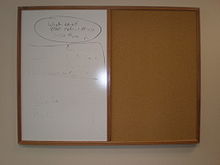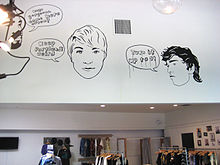- Whiteboard
-
A whiteboard (also known by the terms markerboard, dry-erase board, dry-wipe board, pen-board, and the misnomer greaseboard) is a name for any glossy, usually white surface for nonpermanent markings. Whiteboards are analogous to chalkboards, allowing rapid marking and erasing of markings on their surface. The popularity of whiteboards increased rapidly in the mid-1990s and they have become a fixture in many offices, meeting rooms, school classrooms, and other work environments.
The term whiteboard is also used metaphorically to refer to features of computer software applications that simulate whiteboards. Such "virtual whiteboards" allow one or more people to write or draw images on a simulated canvas. This is a common feature of many virtual meeting, collaboration, and instant messaging applications. The term whiteboard is also used to refer to interactive whiteboards.
Contents
History
The whiteboard was invented by Martin Heit, a photographer and Korean war veteran. The idea was originally developed for having next to a wall phone to take messages down on. During his work with film, he realized that notes could be recorded on film negatives using a sharpie and could be wiped off simply with water. Early whiteboards were made out of film laminate, the same glossy finish found on film negatives.
A prototype was made and ready to be revealed, when the showcase burned down the night previous to its unveiling along with the whiteboard prototype. Mr. Heit chose to sell the idea to Dry-Mark, who began to introduce them into the education world.
In the mid-1960s, the first whiteboards began to appear on the market. In classrooms, their widespread adoption did not occur until the early 1990s when concern over allergies and other potential health risks posed by chalk dust prompted the replacement of many blackboards with whiteboards.[1]
The first whiteboards were very expensive and were made of a melamine surface. It was the "perfect" solution to the chalkboard, except that it "ghosted" (retained residue of erased markings) in a short time and was difficult to keep clean.
Enamel-on-steel magnetic whiteboard has gone through some improvements, such as cost reduction and a reduction in glare caused by the glossy surface. The current trend is porcelain-steel magnetic dry erase boards.[citation needed] These are regarded as the highest quality in the industry.[citation needed] They are now very common in schools, universities, and hospitals.
Glue-backed whiteboard sheets, posters, and rolls are available, permitting any surface, even if irregularly shaped or non-level, to be turned into a whiteboard writing surface.
Clear marker surfaces, made of glass or specially coated acrylic, also appeared on the market about 2007 and were popularized by TV and movies.
Surface materials
There are four types of materials commonly used for whiteboard surfaces:
- Melamine
- A resin-infused paper which is typically used over a substrate that can range from particle board to MDF (medium density fiberboard). Melamine boards range in quality primarily due to the amount of resin deposited on the base material. Some melamine boards will remain clean (no ghosting) for a long time and others will fail prematurely. Generally these least expensive type of whiteboard and most commonly found in use in non-institutional applications. They are available in any office supply stores. It is not possible to quantify how well this type of board will perform due to the wide range of quality. The major brands are generally a good bargain, but institutional (schools, hospitals) and heavily used commercial applications are not a good application for melamine boards
- Painted steel or aluminum
- Painted steel and aluminum dry erase also have a wide range of quality. Painted surfaces tend to be smoother, which leads to better methods of erasing. The painted surface is generally a multiple layer of coatings made up of a base coat in color (most commonly white) and a clear performance coating that is the dry erase component. Paint varies from electron beam cured coatings to UV and other coating systems. Good commercial grade painted steel or aluminum has excellent dry erase properties and many will able to have permanent marker cleaned from the surface. Any coated surface is susceptible to scratching. Painted steel surfaces are magnetic and allow the use of magnets. Painted aluminum surfaces are rarely used as a base for whiteboards as they are not magnetic and are more expensive than steel. Painted steel whiteboards are most commonly used for custom printed whiteboards. These products are used as tracking boards, patient information boards and tournament and training boards.
- Hardcoat laminate
- Every laminate manufacturer makes a dry erase board or laminate. Here again the performance varies over a wide range depending on the amount of resin used in the manufacturer. Basically this category primarily uses melamine as its dry erase performance coat and therefore falls into the melamine universe. Depending on the manufacturer (and the price) these laminate often are less porous and highly resistant to staining. Less common than other whiteboard surfaces, because they usually are used in combination with something else (a cabinet, doors or table tops for example). (this statement applies to Porcelain steel which is the only lifetime warranty available on the market)
- Porcelain, enamel-on-steel
- Ceramic (glass) fired onto a steel surface in a kiln. They are the most durable surfaces and most carry a lifetime warranty. They are very common in high traffic industrial settings. Highly scratch-resistant, although materials harder than glass (like diamond) can scratch them. They do not absorb dry erase or permanent marker ink. They allow the use of magnets. Since it is glass, the porcelain surface can be cleaned with any non-abrasive cleaner, which must then be rinsed off with water to prevent smearing. Permanent marker can be removed by writing over it with a dry-erase marker and erasing it. Some porcelain surfaces provide LEED credit in new construction.
Advantages
- Whiteboard ink markings are less susceptible to external factors, such as water, because the ink adheres in a different manner than does chalk to a chalkboard. Using markers does not generate the dust that comes from using and erasing chalk, allowing their use in areas containing dust-sensitive equipment. Some who are allergic to chalk or are asthmatic use whiteboards as an alternative.
- A whiteboard can be used as the projecting medium for an overhead or video projector. This allows the person giving the presentation to fill in blanks, edit, underline and make comments by writing directly onto the whiteboard, which in turn shows through the projected image. Proper dry wipe boards are high gloss to enable the dry marker ink to be wiped off easily and high gloss surfaces will reflect the projector light, creating a so called "hot spot", a glare back from the board. Semi-matte whiteboards are better suited for projection but more difficult to dry wipe clean.
- A whiteboard pen is easier than chalk to hold and write with. This can benefit persons with limited mobility in their hands, such as those affected by diseases such as arthritis or systemic lupus erythematosus. In addition, marking on a whiteboard takes less time, effort, and pressure than marking on a chalkboard.[citation needed]
- Like chalkboards, whiteboards help to save paper.
- When compared to a chalkboard a whiteboard can have significantly more colors because markers have a greater range of color than chalk (sidewalk chalk).[citation needed]
Disadvantages
- Only special whiteboard markers are suitable for use on whiteboards. Using other markers that resemble whiteboard markers but contain the wrong kind of ink creates markings that are hard or impossible to remove, depending on the surface type (see surface materials above). However, some techniques have been developed, which include filling over them using a marker with the right type of removable ink and then erasing the ink; wiping the marks with acetone or alcohol; or by using board cleaning sprays or pre packaged wipes commercially available from the whiteboard manufacturers.
- The white background can cause contrast problems for people with vision impairment.[citation needed] Additionally, whiteboards cause some problems for those who write left-handed as many write with their hand curved around the pen, therefore causing their hand to drag across the board, smearing the marker strokes previously made. Similarly, right-handed people have this problem with right-to-left languages, such as the very "curvy" and cursive Arabic abjad, and to a lesser extent with the Hebrew abjad (due to the square and differentiated shape of the letters). This limitation is also present with a chalkboard.
- Markers on whiteboards are generally less pressure sensitive than chalk, making it harder to draw heavier/lighter lines
- Whiteboard markers are often sealed in opaque plastics and difficult to determine the amount of ink remaining, only fading in color intensity with use. Like other contemporary markers, they can dry out with if the writing tip is uncapped for long periods of time.
- Whiteboard markers often have a pungent and strong odor (depending on brand and color) whereas chalk has a mild smell mainly from the chalk dust.
- When writing on a vertical surface, most people incline markers upwards, however this impedes the flow of ink which is dependent on gravity.
See also
Notes
- ^ Emily, Thomas. "Reporter". Marketing. http://www.whiteyboard.com/whiteboard.html. Retrieved 30 July 2011.
External links
Categories:- Office equipment
- Writing media
Wikimedia Foundation. 2010.



